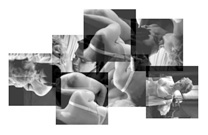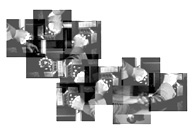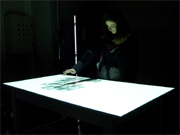- Installation: Concrescence
- Concept + Design: Douglas Edric Stanley
- Exhibition: Créer du sens à l’ère numérique
- Location: H2PTM, Saint-Denis, Paris
- Dates: 24, 25, 26 September, 2003
- Assistant: Pierre-Erick Lefebvre
- Co-producer: CIREN, MSH Paris-Nord
- Video: Concrescence Video Documentation (mp4)
I will be presenting a prototype for an interactive and algorithmic cinema platform, entitled Concrescence. The Concrescence project aims to build a non-linear cinema platform that allows for exploring moving images dynamically. It is both an authoring system, an editing suite, and a projection space. A specific form, the Hypertable, was built for it, allowing users to interact with the complex narrative suites in a simple and intuitive manner.
This prototype was funded by a grant from the DICREAM, Centre National Cinématographique, Ministère de la Culture.
Here are some screenshots from the program:

All images are cut out of the Alfred Hitchcock film Psycho. The film has been sliced, shot-by-shot, into morsels, each being injected into the Concrescence database. The “narrative” was then reconstructed by manipulating images associatively from within the Concrescence software. These connections and threads make up what the user then will explore from the film, through the non-linear process of concrescence. In this way, images are not mixed randomly (a common misconception: oh so it’s random), but rather through non-linear association, which is a very different process indeed. Hence the images are not programmed through some linear narrative, nor are they randomly thrown about the surface of the Hypertable. It’s a middle ground, where the user explores different possibilities, and the computer offers up related imagery and narrative elements in relation to manipulated images..

Described in a different light, we might say that the “body” of the film itself has been cut into pieces and placed into a trunk lowered into the swamps. By warming the surface of the table with one’s hand, images rise to the surface out of the swampy mass, and mix with other images also floating on the surface that are similar to it.

As such, it is the film itself that has been placed on the operating table. This explains the choice of the form itself of the table: we were trying to build something that would evoke the operating room, although something a little more ancient, almost like the operating room tables of Charcot and his hysterics.

